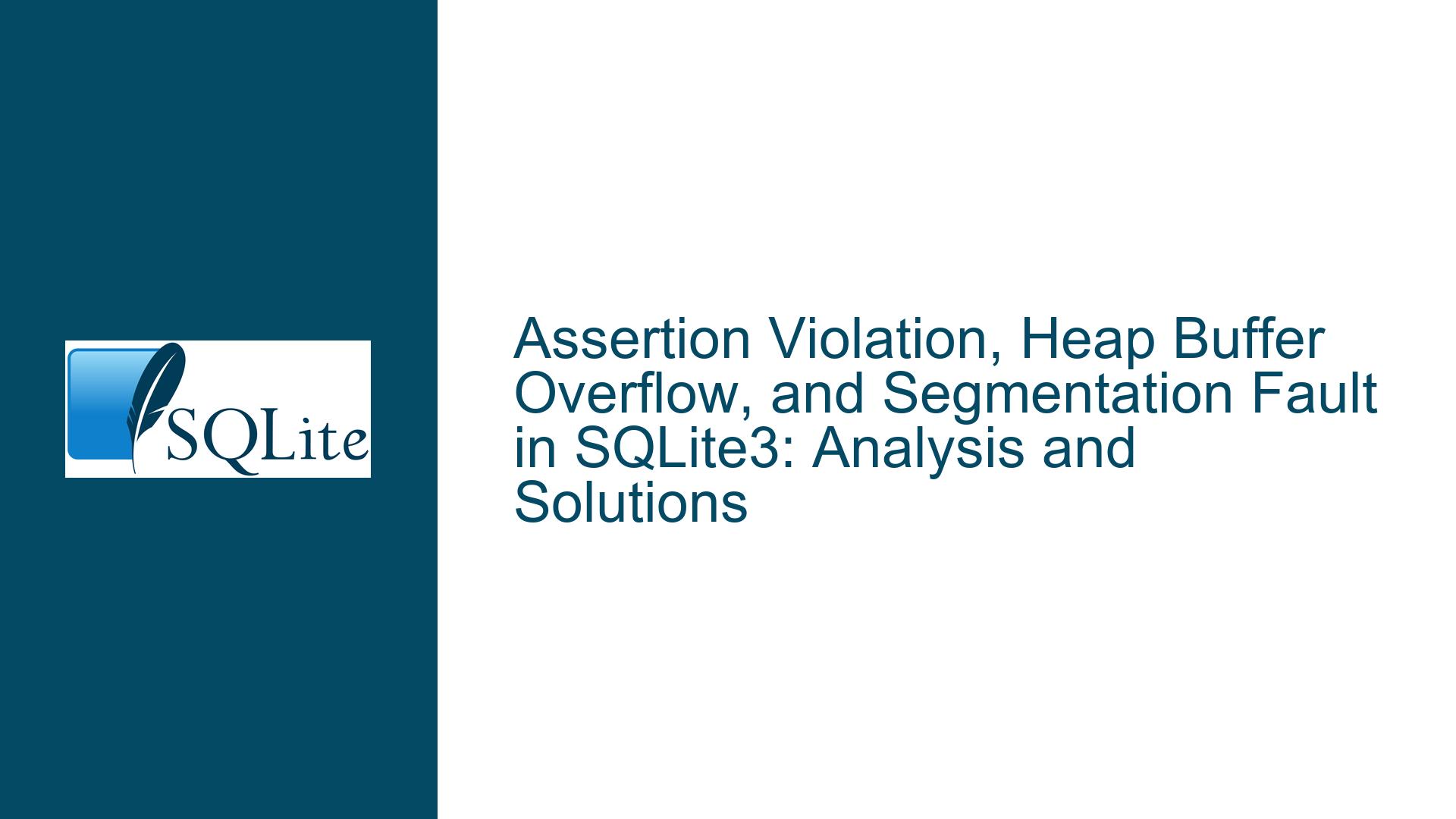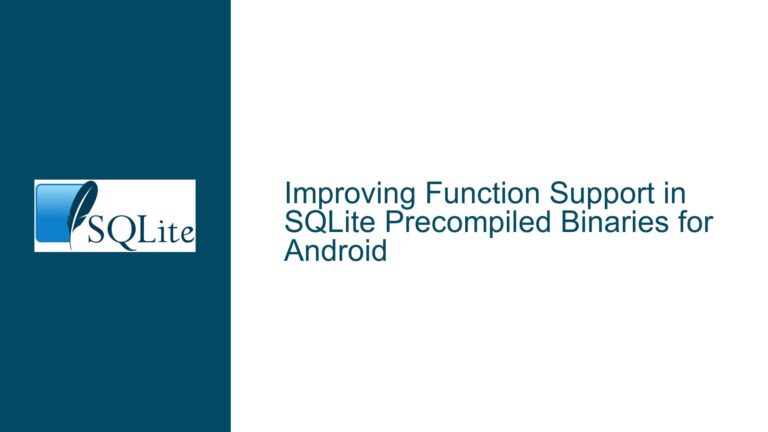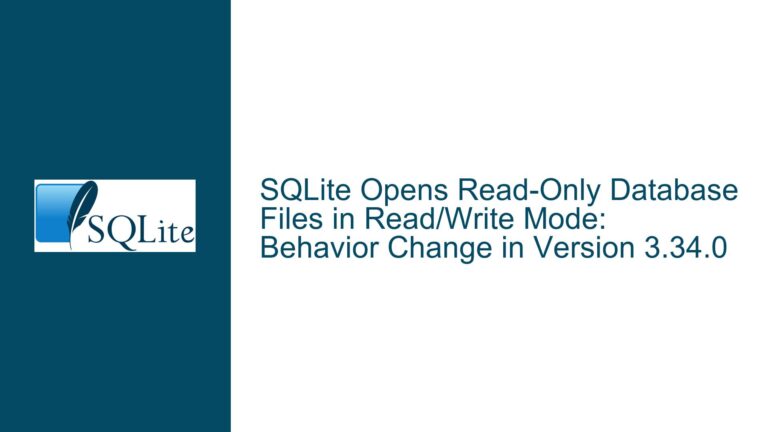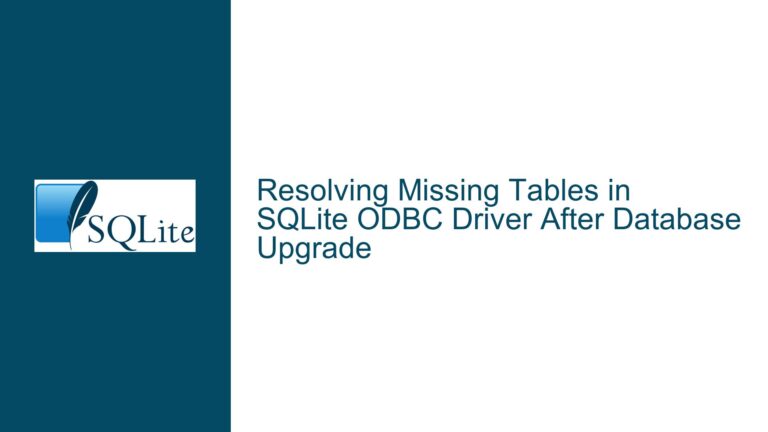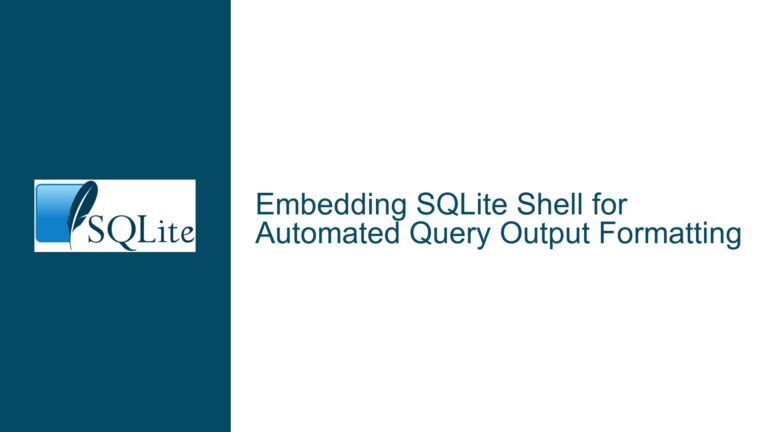Assertion Violation, Heap Buffer Overflow, and Segmentation Fault in SQLite3: Analysis and Solutions
Issue Overview: Assertion Violation, Heap Buffer Overflow, and Segmentation Fault in SQLite3
The issues reported in the discussion revolve around three primary problems encountered during the testing of SQLite3 using grammar-based fuzzers. These issues include an assertion violation, heap buffer overflow, and a segmentation fault. Each of these issues manifests under specific conditions, often involving complex SQL queries or schema manipulations. The problems were identified while running SQLite3 compiled with AFL++ and ASAN (AddressSanitizer), which are tools designed to detect memory corruption and other runtime errors.
The assertion violation occurs when the SQLite3 parser encounters a specific sequence of SQL commands, particularly involving the creation of temporary tables and triggers. The violation is triggered by an assertion in the sqlite3AddReturning function, which checks whether the pParse->bReturning flag is set to 0. When this assertion fails, the program aborts, indicating a logical inconsistency in the parser’s state.
The heap buffer overflow issues are more varied and occur in different contexts. One instance involves the creation of a temporary table with a large number of columns, followed by an ALTER TABLE command that adds a generated column. Another instance occurs when executing a SELECT DISTINCT query with a large number of arguments. These overflows are detected by ASAN, which reports out-of-bounds memory accesses.
The segmentation fault is observed when executing a complex EXPLAIN query with a large number of columns and an ORDER BY clause. This fault is caused by a high-value address dereference, leading to a crash in the sqlite3VdbeDisplayP4 function.
Possible Causes: Root Causes of the Assertion Violation, Heap Buffer Overflow, and Segmentation Fault
Assertion Violation
The assertion violation is rooted in the SQLite3 parser’s handling of the RETURNING clause in SQL statements. The pParse->bReturning flag is used to track whether a RETURNING clause is being processed. The assertion pParse->bReturning==0 suggests that the parser expects this flag to be reset before processing a new RETURNING clause. However, in the provided test cases, the flag is not reset correctly, leading to the assertion failure. This could be due to a logical error in the parser’s state management, where the flag is not cleared after processing a RETURNING clause in a trigger or a similar context.
Heap Buffer Overflow
The heap buffer overflow issues are caused by insufficient bounds checking in the SQLite3 code, particularly in the CLI (Command Line Interface) input buffer and the handling of generated columns. In the first case, the overflow occurs in the shell_error_context function, which is part of the SQLite3 shell. This function attempts to read beyond the allocated buffer, leading to an out-of-bounds access. The issue is exacerbated when the input buffer is filled with a large number of columns or complex SQL commands.
In the second case, the overflow occurs during the execution of a SELECT DISTINCT query with a large number of arguments. The SQLite3 engine allocates a buffer to store the results of the query, but the buffer size is insufficient to accommodate the large number of arguments, leading to an overflow. This is a classic case of inadequate memory allocation for dynamic SQL queries.
Segmentation Fault
The segmentation fault is caused by a high-value address dereference in the sqlite3VdbeDisplayP4 function. This function is responsible for displaying the P4 operand of a VDBE (Virtual Database Engine) instruction. The fault occurs when the function attempts to dereference a pointer that points to an invalid memory location. This could be due to an error in the VDBE instruction generation or a misalignment in the memory layout of the SQLite3 engine.
Troubleshooting Steps, Solutions & Fixes: Addressing the Assertion Violation, Heap Buffer Overflow, and Segmentation Fault
Assertion Violation
To address the assertion violation, the SQLite3 parser’s state management logic needs to be reviewed and corrected. Specifically, the pParse->bReturning flag should be reset after processing a RETURNING clause. This can be achieved by adding a reset operation in the appropriate location within the parser code. Additionally, the parser should be tested with a variety of SQL commands to ensure that the flag is managed correctly in all scenarios.
Solution:
- Locate the code responsible for setting and resetting the
pParse->bReturningflag. - Ensure that the flag is reset after processing a
RETURNINGclause. - Add additional assertions or logging to track the state of the flag during parsing.
- Test the parser with a wide range of SQL commands, including those that involve triggers and temporary tables.
Heap Buffer Overflow
The heap buffer overflow issues can be mitigated by improving the bounds checking in the SQLite3 code. For the CLI input buffer, the size of the buffer should be increased, and additional checks should be added to ensure that the buffer is not overrun. For the SELECT DISTINCT query, the SQLite3 engine should allocate a larger buffer to accommodate the results of the query.
Solution:
- Increase the size of the CLI input buffer and add bounds checking in the
shell_error_contextfunction. - Modify the SQLite3 engine to allocate a larger buffer for
SELECT DISTINCTqueries with a large number of arguments. - Add additional checks to ensure that the buffer is not overrun during query execution.
- Test the SQLite3 engine with a variety of complex SQL commands to ensure that the buffer overflows are prevented.
Segmentation Fault
The segmentation fault can be addressed by reviewing the VDBE instruction generation and memory layout in the SQLite3 engine. The sqlite3VdbeDisplayP4 function should be modified to handle invalid memory addresses gracefully, and additional checks should be added to ensure that the P4 operand is valid before dereferencing it.
Solution:
- Review the VDBE instruction generation code to ensure that the P4 operand is valid.
- Modify the
sqlite3VdbeDisplayP4function to handle invalid memory addresses gracefully. - Add additional checks to ensure that the P4 operand is valid before dereferencing it.
- Test the SQLite3 engine with a variety of complex SQL commands to ensure that the segmentation fault is prevented.
Conclusion
The issues reported in the discussion highlight the importance of thorough testing and robust error handling in database systems like SQLite3. The assertion violation, heap buffer overflow, and segmentation fault are all serious issues that can lead to crashes or security vulnerabilities. By addressing these issues through careful code review, improved bounds checking, and enhanced state management, the stability and reliability of SQLite3 can be significantly improved. The solutions outlined above provide a roadmap for resolving these issues and ensuring that SQLite3 continues to be a robust and reliable database engine.
